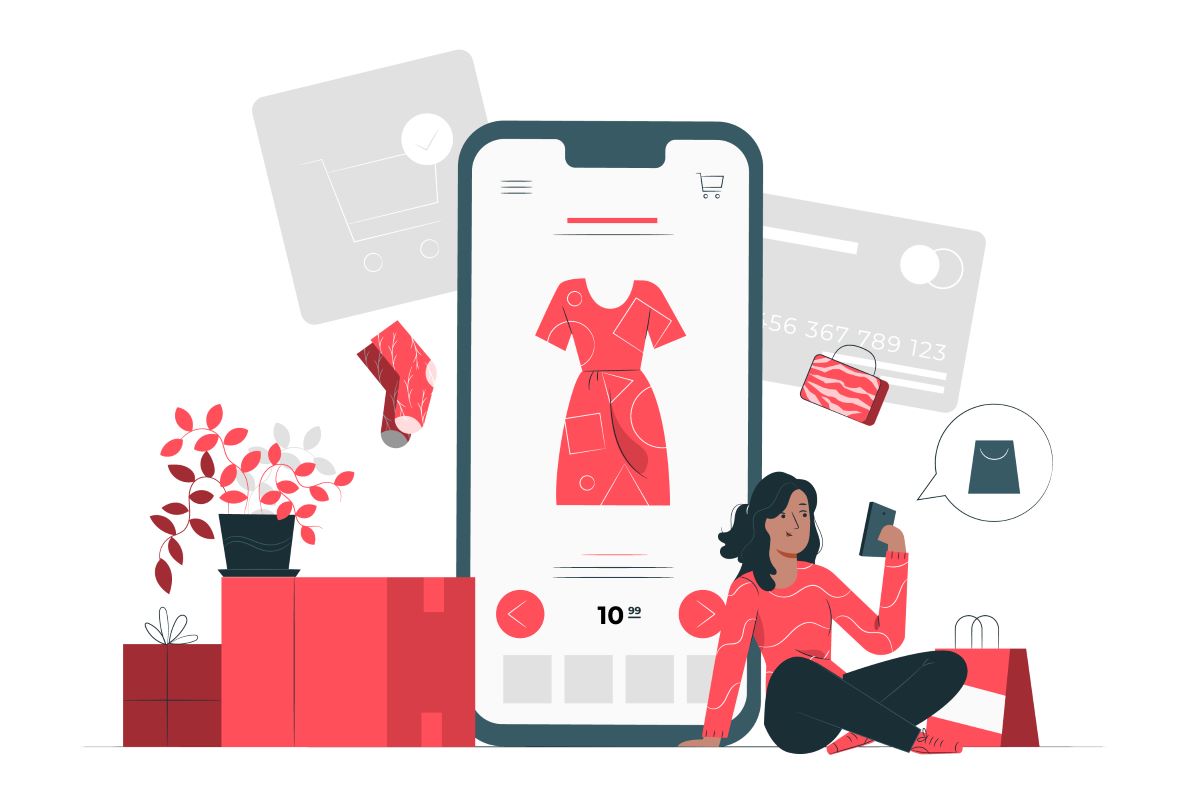Everything You Need to Know About Mobile Commerce (Ultimate Guide)
E-Commerce businesses of all sizes are constantly looking for new ways to simplify the buying process for their customers and to enhance their shopping experience while increasing their sales at the same time. Today, we can say that mobile commerce is one of the best ways to do that. In this article, we will walk you through everything you need to know about mobile commerce.
Table of Content:
- What is Mobile Commerce?
- What is the difference between mCommerce and eCommerce?
- 4 Main differences between mCommerce and eCommerce?
- How does Mobile Commerce work?
- Statistics about Mobile Commerce
- Advantages of Mobile Commerce
- Disadvantages of Mobile Commerce
What is Mobile Commerce (M-commerce)?
Mobile Commerce, also referred to as mCommerce, refers to the use of wireless devices that are handheld to perform commercial transactions online. These devices are like cell phones and tablets, and these online commercial transactions include several types, such as the:
- The buying and selling of products and services.
- Mobile/Online banking
- The paying of different types of bills
- The transferring of money
What is the Difference between mCommerce and eCommerce?
You are probably asking yourself now what makes mCommerce different from eCommerce.
Well, it is important to first understand that Mobile Commerce is a form or a subcategory of eCommerce. Some people even call it an “evolution”, an “upgraded version'' or even an “inevitable variation” of eCommerce. However, the main difference between them is that mCommerce allows your customers to access your online websites and your other platforms without having to use a desktop computer or a laptop.
In other words, eCommerce, which stands for Electronic Commerce, is a general term for buying and selling goods and services via the Internet or for conducting commercial transactions online. It is a broad term mainly concerned with the overall customers’ online shopping experience, in general.
As for mCommerce, it has a narrower and more specific scope. It focuses on the customers’ online shopping experience via mobile devices, in particular.
4 Main Differences Between mCommerce and eCommerce
1- Portability, Mobility, and Reachability
The first and most obvious differences between mCommerce and eCommerce, are their portability, their mobility, and hence, their reachability.
As we said, eCommerce is mainly performed using desktop computers or laptops that have an Internet connection. For this, customers usually have to look for a place where they can sit, connect to the Internet, and do their transactions. As for mCommerce, it is conducted using wireless devices such as mobile phones and tablets. It is no brainer that such devices, being more mobile and easily portable, are much easier and quicker to use than computers or laptops.
For example, your customers can use their mobile phones to open the mobile app for your eCommerce store and make purchases easily and quickly at any time or any place. They can even buy your products or services while taking a walk. However, it is much harder to open a laptop, connect it to the Internet, and make a purchase while being on your feet.
Also, because of the fact that your customers carry their mobile devices with them almost everywhere, mCommerce has the ability to reach more customers than eCommerce does.
2- Location Tracking
The portability of mCommerce devices does not just affect the reachability of customers, but it also affects something very important today which is location tracking.
Location tracking on mCommerce devices goes way beyond just the IP address tracking used by traditional eCommerce websites on computers, which can only provide a vague, non-specific idea of the place of customers.
However, mCommerce devices have more capabilities and track customers’ locations using different tools, such as GPS technology and Wi-Fi. These capabilities allow for creating location-specific content and employing personalization in the recommendations that you send to your customers.
3- Push Notifications
Another obvious difference between eCommerce and mCommerce is the ability of mCommerce devices to use push notifications. Push notifications are messages that pop up from your app on the mobile devices of your customers even when the app is not open or even when they are not using their mobile devices at all. What matters is that your mCommerce app is installed on the mobile devices of your customers.
As opposed to promotional emails used by eCommerce websites, which can be delivered to the spam folder or be ignored by customers, the push notifications used by mCommerce are delivered directly to the user’s mobile; and hence, are more visible and harder to ignore.
4- Security
Whether we are talking about eCommerce or mCommerce, security remains the most important aspect when conducting a transaction online. Even though the number of eCommerce businesses is increasing by the day, customers still feel a little worried about sharing the data of their credit cards or debit cards when buying something online.
Today, mCommerce is succeeding more than eCommerce is managing customers' skepticism. Unlike eCommerce websites that only depend on usernames and passwords to ensure security, mCommerce devices use more extensive techniques, such as multi-factor authentication and biometric authentication (via face recognition, fingerprints, and retina scans).
Moreover, mCommerce is trying to bridge the security gaps by introducing other methods of payment that may substitute the use of credit or debit cards, such as mobile wallets.
All this definitely contributes to reducing the risks of deceiving transactions, which makes customers feel more safe while making purchases online.
M-commerce Vs e-commerce
How does Mobile Commerce Work?
The essence of how mobile commerce works lies in having three main elements:
- a mobile device
- a mobile app that is user-friendly
- a wireless network to which this device is connected.
Mobile commerce utilizes these elements to allow customers to conduct different types of transactions online with a few simple clicks on a screen.
You are probably now wondering how mobile payment products work. Well, it is pretty simple. Mobile payment is characterized by being a contactless-type of payment. It uses different technologies, such as Near Field Communication Technology, which allows your customers to wave their mobile devices over a payment terminal to pay for a product or a service.
Additionally, there are a few important KPIs that help better understand how mCommerce is working, and that should be taken into consideration by the developers of mCommerce applications, such as total traffic on the application, number of subscribers, number of visitors converting into customers, average order value, and others.
Statistics about Mobile Commerce
Here we gathered for you some of the most important statistics related to Mobile Commerce:
- Mobile Commerce sales are expected to exceed $430 billion in 2022 and $710 billion in 2025 (Tidio, 2022).
- Time in shopping apps reached over 100 billion hours spent globally (Tidio, 2022)
- M-commerce market share comprises 73% of total e-commerce (Zippia, 2022)
- In the last six months, around 79% of customers who use smartphones made an online purchase (woosuite, 2022).
- By 2022, the e-commerce market is projected to grow to $845 billion, 50% of which will come from mobile commerce sales (Apps That Deliver, 2022).
- 69.4% of internet users use shopping apps on their mobile devices (SaveMyCent, 2022).
These are definitely not the only statistics related to mobile commerce; however, these are enough to prove to you that mobile commerce is on the rise.
What are the Advantages and Disadvantages of Mobile Commerce?
Just like anything else, mobile commerce has advantages that we can make use of and disadvantages that we can try to avoid. Here are some of the most important advantages and disadvantages of mCommerce that you should always take into consideration.
• Mobile Commerce Advantages
1- Provides an Omnichannel experience
If you run an eCommerce business and want to have a true omnichannel experience, then mobile commerce is an indispensable channel for you to achieve that and to create a seamless shopping experience for your customers. Omnichannel experience refers to reaching out to your customers on all the channels, platforms, and devices that they might be using. It also refers to using these channels to market, sell, and provide customer service in an integrated, cohesive way.
Now, do you believe it is possible to achieve such a thing without mobile commerce?
Absolutely not.
The omnichannel experience is based on meeting your customers wherever they are, and since cell phones and tablets are easily portable and are probably with your customers all the time, mobile commerce is an essential component to complete the omnichannel experience.
2- Increases Profits and Lowers Costs
All the statistics point out that profits and revenues of eCommerce businesses have the potential to increase if they know how to use mCommerce properly. To illustrate better, by utilizing mobile commerce, eCommerce businesses encourage customers to buy through simplifying the buying and checkout processes. This leads to reducing cart abandonment; and hence, leads to increase sales, profits, and revenues.
Moreover, mCommerce can lead to the reduction of some costs. For example, by connecting directly to customers through mobile apps, you can market your new products or services using the app without spending so much money on marketing campaigns, whether physically or digitally.
3- Offers more insights on customers
Mobile commerce and its devices can help you gain better insights on your customers. The customer data that is collected through mobile apps can help you identify their buying behaviors, interests, time spent on the app, and other useful information. You can use this information to create a more personalized shopping experience for your customers.
4- Increases the number of payment options
Another way in which mobile commerce makes the buying process easier is the variety of payment options that it offers. Today, mCommerce goes beyond the traditional “Cash or Card” payment option to include other easy options such as mobile wallets, Apple Pay, PayPal One Touch, and Amazon Pay.
Additionally, today, mCommerce offers one-click checkout functionalities, which spare customers the hassle of having to enter their payment information every time they make a purchase; instead, it allows them to register their payment information only once and then use the one-click option for all future transactions.
5- Target your customer at the right time
Mobile commerce allows you to reach your customers at the right time. This right time could be the moment before they decide to buy a product or a service, for example. Advertising technology based on demographics and location tracking can help you connect with your customers at that exact moment, which would increase the probability of them completing the transaction and making the purchase.
6- Convenience
This advantage can be regarded as a result of all the previously discussed points. To demonstrate, mCommerce devices:
- Are mobile and portable; therefore, they are more accessible and can reach more customers.
- Reach customers wherever they are and with content customized specifically to their exact locations.
- Guarantee a higher level of security.
All this makes the use of mCommerce devices more convenient to customers than the use of traditional eCommerce websites only.
• Mobile Commerce disadvantages
1- High level of competitiveness in the market
The number of companies and eCommerce businesses that started investing in mobile commerce has been increasing over the past few years. In order for you to join the market, you have to find a way to differentiate yourself and have a competitive advantage over others.

2- The dependence on technology
Investing in mobile commerce will definitely increase your dependence on technology. This will require you to expect possible downtimes in your mobile apps and your servers and to create backup options in advance.
In other words, you have to consider your uptime percentage as a key metric and to always be ready in case your mobile app crashes or cannot be accessed, which will directly affect your sales.
3- The need to constantly optimize
Even though mobile commerce is rising every day, the average conversion rate for desktop devices is still more than that for smartphones. The reason behind this is likely to be the difference in the screen size. Mobile devices completely differ in their screen size, layout, and operating systems. Therefore, mobile websites and apps must be constantly optimized to appeal to customers.
4- Privacy concerns and Security issues
First, the extra amount of customer data that mobile commerce allows you to collect can be a disadvantage as much as it can be an advantage. The more personal information you collect about your customers, the greater your responsibility to protect this information becomes.
This is no easy responsibility. It requires you to allocate a lot of effort and resources into protecting your customers' data; and into making it transparent to them how their data is being collected, stored, or shared.
Also, if anything happens to this data or if it gets leaked in any way, this is definitely going to be on you.
Second, as for the security issues, even though we mentioned at the beginning of this article that mCommerce devices provide more security options than traditional eCommerce, there are still chances of hackers attacking your mobile apps.
Final Thoughts
Even though mobile commerce has a few disadvantages, its advantages are much more significant and outstanding. The number of customers accessing eCommerce stores from their mobile devices is increasing every day. Therefore, utilizing mobile commerce is becoming a necessity today; and for that, you might need a tool or an operating system to help you.
A marketing operating system like ConvertedIn can facilitate the process of reaching your customers on all their mobile devices by automating your ads on different social media platforms and automating your SMS and email marketing campaigns.
It can also help you benefit from the personalization opportunities that mobile commerce has to offer by, for example, recommending personalized products for your customers.
Book a demo now to learn more about what ConvertedIn has to offer and to start utilizing mobile commerce to grow your eCommerce business.
 By
By

